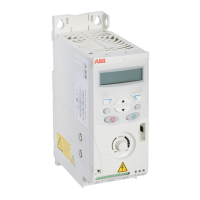Actual signals and parameters
Parameters in the Long parameter mode
Activates the switching frequency control. When active, the selection of
parameter 2606 SWITCHING FREQ is limited when the drive internal
temperature increases. See the figure below. This function allows the highest
possible switching frequency at a specific operation point.
Higher switching frequency results in lower acoustic noise, but higher internal
losses.
f
sw
limi
t
12 kHz
8 kHz
Drive
temperature
4 kHz
T
100 °C 110 °C 120 °C
Switching frequency can adapt to loading instead of limiting the output
current. This allows maximum loading with all switching frequency selections.
The drive automatically decreases the actual switching frequency if loading is
too high for the selected switching frequency.
Defines the slip gain for the motor slip compensation control. 100% means
full slip compensation, 0% means no slip compensation. Other values can be
used if a static speed error is detected despite of the full slip compensation.
Example: 35 Hz constant speed reference is given to the drive. Despite of the
full slip compensation (SLIP COMP RATIO = 100%), a manual tachometer
measurement from the motor axis gives a speed value of 34 Hz. The static
speed error is 35 Hz - 34 Hz = 1 Hz. To compensate the error, the slip gain
should be increased.
Enables the noise smoothing function. Noise smoothing distributes the
acoustic motor noise over a range of frequencies instead of a single tonal
frequency resulting in lower peak noise intensity. A random component with
an average of 0 Hz is added to the switching frequency set by parameter
2606 SWITCHING FREQ.
Note: Parameter has no effect if parameter 2606 SWITCHING FREQ is set
to 16 kHz.
Enables or disables the DC voltage stabilizer. The DC stabilizer is used to
prevent possible voltage oscillations in the drive DC bus caused by motor
load or weak supply network. In case of voltage variation, the drive tunes the
frequency reference to stabilize the DC bus voltage and therefore the load
torque oscillation.

